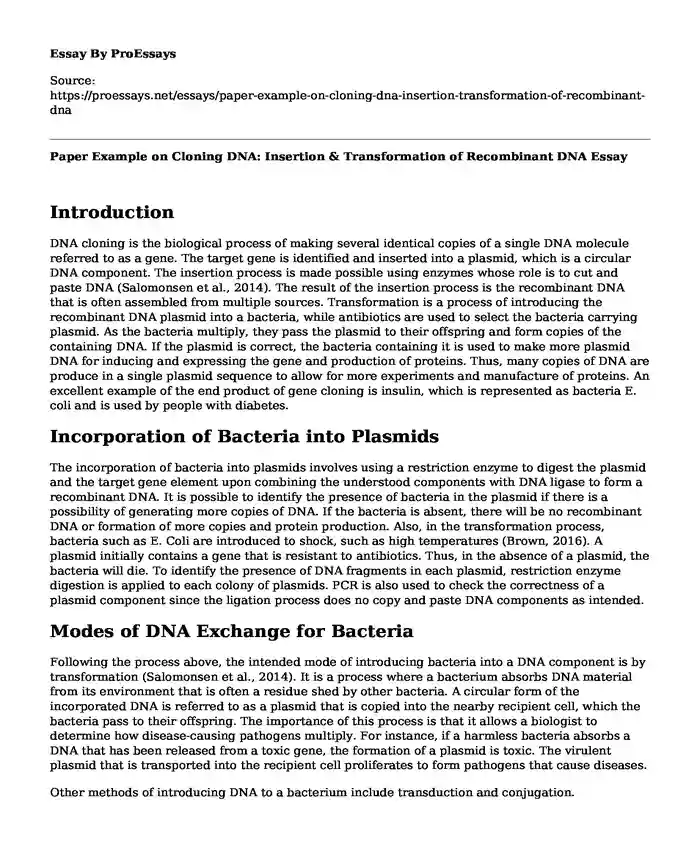Introduction
DNA cloning is the biological process of making several identical copies of a single DNA molecule referred to as a gene. The target gene is identified and inserted into a plasmid, which is a circular DNA component. The insertion process is made possible using enzymes whose role is to cut and paste DNA (Salomonsen et al., 2014). The result of the insertion process is the recombinant DNA that is often assembled from multiple sources. Transformation is a process of introducing the recombinant DNA plasmid into a bacteria, while antibiotics are used to select the bacteria carrying plasmid. As the bacteria multiply, they pass the plasmid to their offspring and form copies of the containing DNA. If the plasmid is correct, the bacteria containing it is used to make more plasmid DNA for inducing and expressing the gene and production of proteins. Thus, many copies of DNA are produce in a single plasmid sequence to allow for more experiments and manufacture of proteins. An excellent example of the end product of gene cloning is insulin, which is represented as bacteria E. coli and is used by people with diabetes.
Incorporation of Bacteria into Plasmids
The incorporation of bacteria into plasmids involves using a restriction enzyme to digest the plasmid and the target gene element upon combining the understood components with DNA ligase to form a recombinant DNA. It is possible to identify the presence of bacteria in the plasmid if there is a possibility of generating more copies of DNA. If the bacteria is absent, there will be no recombinant DNA or formation of more copies and protein production. Also, in the transformation process, bacteria such as E. Coli are introduced to shock, such as high temperatures (Brown, 2016). A plasmid initially contains a gene that is resistant to antibiotics. Thus, in the absence of a plasmid, the bacteria will die. To identify the presence of DNA fragments in each plasmid, restriction enzyme digestion is applied to each colony of plasmids. PCR is also used to check the correctness of a plasmid component since the ligation process does no copy and paste DNA components as intended.
Modes of DNA Exchange for Bacteria
Following the process above, the intended mode of introducing bacteria into a DNA component is by transformation (Salomonsen et al., 2014). It is a process where a bacterium absorbs DNA material from its environment that is often a residue shed by other bacteria. A circular form of the incorporated DNA is referred to as a plasmid that is copied into the nearby recipient cell, which the bacteria pass to their offspring. The importance of this process is that it allows a biologist to determine how disease-causing pathogens multiply. For instance, if a harmless bacteria absorbs a DNA that has been released from a toxic gene, the formation of a plasmid is toxic. The virulent plasmid that is transported into the recipient cell proliferates to form pathogens that cause diseases.
Other methods of introducing DNA to a bacterium include transduction and conjugation. Transduction involves the process whereby viruses intruding bacteria transport short components of chromosomal DNA accidentally from one bacterium to another. The results of this process are a series of bacteriophages that continue multiplying even when invaded with DNA components. The other method is conjugation, which involves the transfer of one DNA component from one bacterium to another (Brown, 2016). A donor cell uses the pilus structure to move closer to the recipient cell and allow this transfer of DNA that is often in the form of a plasmid.
References
Brown, T. A. (2016). Gene cloning and DNA analysis: an introduction. John Wiley & Sons. https://books.google.com/books?hl=en&lr=&id=pi3dCQAAQBAJ&oi=fnd&pg=PR17&dq=gene+cloning&os=C4-9Y-b4W7&sig=dd_UKuUAF8MVksA5i7sBSyd7tiw
Salomonsen, B., Mortensen, U. H., & Halkier, B. A. (2014). USER-derived cloning methods and their primer design. In DNA cloning and assembly methods (pp. 59-72). Humana Press, Totowa, NJ. https://link.springer.com/protocol/10.1007/978-1-62703-764-8_5
Cite this page
Paper Example on Cloning DNA: Insertion & Transformation of Recombinant DNA. (2023, Oct 02). Retrieved from https://proessays.net/essays/paper-example-on-cloning-dna-insertion-transformation-of-recombinant-dna
If you are the original author of this essay and no longer wish to have it published on the ProEssays website, please click below to request its removal:
- Essay Sample on Metabolism and Urinary System
- Research Paper on Extinction & Endangered Species: A Human-Catalyzed Catastrophe
- An Otter's Symbolism: Power, Peace, Family & More - Research Paper
- Essay Example on Winter Survival: Nature's Mysteries, Animal Adaptations
- Birds Show Cognitive Attributes on Par With Mammals - Essay Sample
- Taylor Sanaura: Exploring Animal Lives Through Art for 28 Years - Essay Sample
- How Wolves Change Rivers - Movie Review Sample







